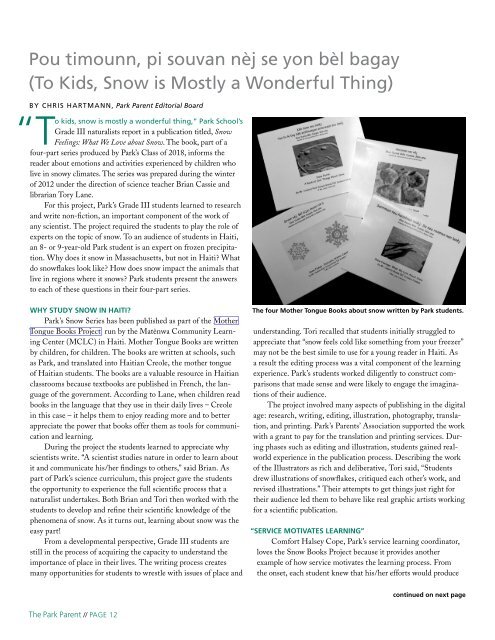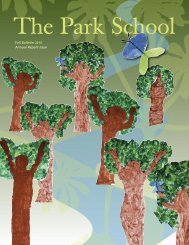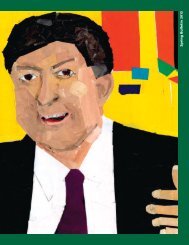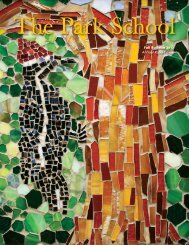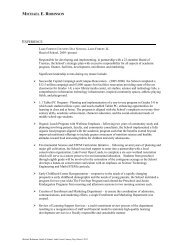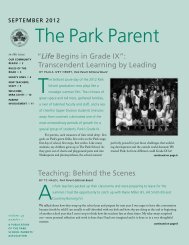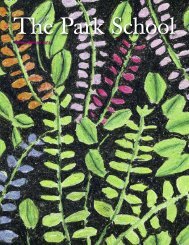The Park Parent April-May 2013 - The Park School
The Park Parent April-May 2013 - The Park School
The Park Parent April-May 2013 - The Park School
Create successful ePaper yourself
Turn your PDF publications into a flip-book with our unique Google optimized e-Paper software.
Pou timounn, pi souvan nèj se yon bèl bagay(To Kids, Snow is Mostly a Wonderful Thing)BY CHRIS HARTMANN, <strong>Park</strong> <strong>Parent</strong> Editorial Board“To kids, snow is mostly a wonderful thing,” <strong>Park</strong> <strong>School</strong>’sGrade III naturalists report in a publication titled, SnowFeelings: What We Love about Snow. <strong>The</strong> book, part of afour-part series produced by <strong>Park</strong>’s Class of 2018, informs thereader about emotions and activities experienced by children wholive in snowy climates. <strong>The</strong> series was prepared during the winterof 2012 under the direction of science teacher Brian Cassie andlibrarian Tory Lane.For this project, <strong>Park</strong>’s Grade III students learned to researchand write non-fiction, an important component of the work ofany scientist. <strong>The</strong> project required the students to play the role ofexperts on the topic of snow. To an audience of students in Haiti,an 8- or 9-year-old <strong>Park</strong> student is an expert on frozen precipitation.Why does it snow in Massachusetts, but not in Haiti? Whatdo snowflakes look like? How does snow impact the animals thatlive in regions where it snows? <strong>Park</strong> students present the answersto each of these questions in their four-part series.WHY STUDY SNOW IN HAITI?<strong>Park</strong>’s Snow Series has been published as part of the MotherTongue Books Project run by the Matènwa Community LearningCenter (MCLC) in Haiti. Mother Tongue Books are writtenby children, for children. <strong>The</strong> books are written at schools, suchas <strong>Park</strong>, and translated into Haitian Creole, the mother tongueof Haitian students. <strong>The</strong> books are a valuable resource in Haitianclassrooms because textbooks are published in French, the languageof the government. According to Lane, when children readbooks in the language that they use in their daily lives – Creolein this case – it helps them to enjoy reading more and to betterappreciate the power that books offer them as tools for communicationand learning.During the project the students learned to appreciate whyscientists write. “A scientist studies nature in order to learn aboutit and communicate his/her findings to others,” said Brian. Aspart of <strong>Park</strong>’s science curriculum, this project gave the studentsthe opportunity to experience the full scientific process that anaturalist undertakes. Both Brian and Tori then worked with thestudents to develop and refine their scientific knowledge of thephenomena of snow. As it turns out, learning about snow was theeasy part!From a developmental perspective, Grade III students arestill in the process of acquiring the capacity to understand theimportance of place in their lives. <strong>The</strong> writing process createsmany opportunities for students to wrestle with issues of place and<strong>The</strong> four Mother Tongue Books about snow written by <strong>Park</strong> students.understanding. Tori recalled that students initially struggled toappreciate that “snow feels cold like something from your freezer”may not be the best simile to use for a young reader in Haiti. Asa result the editing process was a vital component of the learningexperience. <strong>Park</strong>’s students worked diligently to construct comparisonsthat made sense and were likely to engage the imaginationsof their audience.<strong>The</strong> project involved many aspects of publishing in the digitalage: research, writing, editing, illustration, photography, translation,and printing. <strong>Park</strong>’s <strong>Parent</strong>s’ Association supported the workwith a grant to pay for the translation and printing services. Duringphases such as editing and illustration, students gained realworldexperience in the publication process. Describing the workof the Illustrators as rich and deliberative, Tori said, “Studentsdrew illustrations of snowflakes, critiqued each other’s work, andrevised illustrations.” <strong>The</strong>ir attempts to get things just right fortheir audience led them to behave like real graphic artists workingfor a scientific publication.“SERVICE MOTIVATES LEARNING”Comfort Halsey Cope, <strong>Park</strong>’s service learning coordinator,loves the Snow Books Project because it provides anotherexample of how service motivates the learning process. Fromthe onset, each student knew that his/her efforts would producecontinued on next page<strong>The</strong> <strong>Park</strong> <strong>Parent</strong> // PAGE 12


